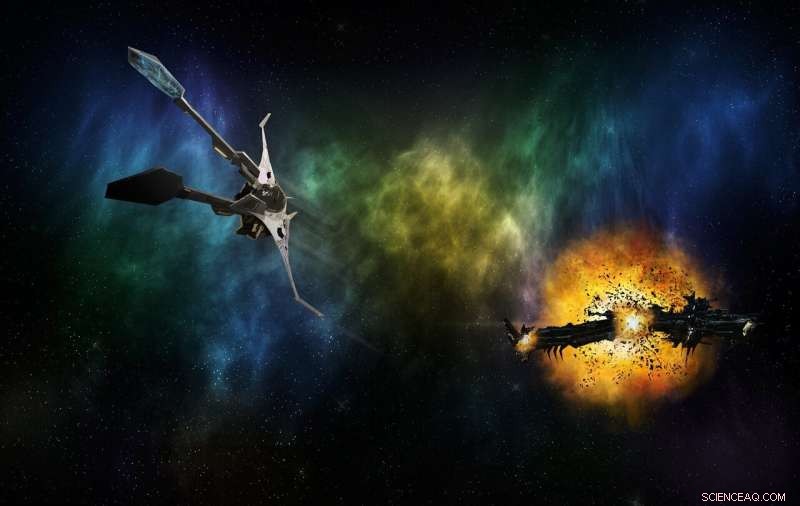
Crédito:Pixabay / CC0 Public Domain
Las películas espaciales de ciencia ficción pueden hacer un mal trabajo al educar a la gente sobre el espacio. En el cine, Los pilotos de tiro caliente dirigen sus naves espaciales en duelo a través del espacio como si estuvieran volando a través de una atmósfera. Se ladean y giran y realizan vueltas y vueltas, tal vez lanzar un giro rápido de Immelman, como si estuvieran sujetos a la gravedad de la Tierra. ¿Es eso realista?
No.
En realidad, Es probable que una batalla espacial se vea muy diferente. Con una presencia cada vez mayor en el espacio, y el potencial de conflictos futuros, ¿Es hora de pensar en cómo sería una batalla espacial real?
La Corporación Aeroespacial sin fines de lucro cree que es hora de considerar cómo sería una batalla espacial real. La Dra. Rebecca Reesman del Centro de Política y Estrategia Espacial de la Corporación Aeroespacial y su colega James R. Wilson han escrito un artículo sobre el tema de las batallas espaciales, titulado "La física de la guerra espacial:cómo la dinámica orbital restringe los compromisos espacio-espacio".
Si los asuntos humanos pasados indican el futuro, entonces procederá la militarización del espacio. Eso es a pesar de que se habla de mantener el espacio en paz, ya pesar de los tratados que dicen lo mismo. Por eso es importante que a medida que más naciones aumenten su presencia en el espacio, y a medida que la competencia por los recursos comienza a causar problemas, que la conversación sobre el conflicto espacial dé un giro realista.
Ese es el caso que hacen los autores en la introducción a su artículo. "Mientras Estados Unidos y el mundo discuten la posibilidad de que el conflicto se extienda al espacio, Es importante tener una comprensión general de lo que es físicamente posible y práctico. Escenas de Star Wars, los libros y los programas de televisión retratan un mundo muy diferente al que probablemente veremos en los próximos 50 años, si alguna vez, dadas las leyes de la física ".
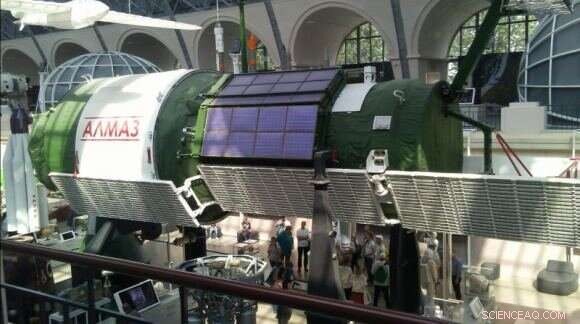
Una estación espacial tripulada Almaz soviética en el Centro de Aviación y Cosmonáutica en Moscú. Rusia diseñó varios tipos de satélites militares y estaciones espaciales, algunos armados con una ametralladora, antes de abandonar la idea por ser demasiado cara. Crédito:Por Pulux11 - Trabajo propio, CC BY-SA 4.0
Todavía no ha habido una batalla en el espacio. Pero ha habido alguna actividad de prueba de armas. China está trabajando en armas antisatélite y ha probado un misil antisatélite. India también. Rusia también está trabajando en capacidades antisatélite, y Estados Unidos está haciendo lo mismo. Estados Unidos de hecho destruyó uno de sus propios satélites con un misil en 1985.
Es probable que esto sea solo la punta del iceberg cuando se trata de conflictos futuros en el espacio. Ninguna de esta actividad antisatélite involucró a personas que viajaban en naves espaciales, y puede que nunca haya necesidad de naves espaciales militares tripuladas, según el papel. "Los enfrentamientos espacio-espacio en un conflicto moderno se librarían únicamente con vehículos sin tripulación controlados por operadores en tierra y fuertemente restringidos por los límites que la física impone al movimiento en el espacio".
En los primeros días de la era espacial, mientras la Guerra Fría todavía estaba en su apogeo, las superpotencias imaginaron que el conflicto en el espacio sería en gran parte una extensión de los conflictos terrestres. Los soviéticos incluso diseñaron estaciones espaciales armadas con una ametralladora para defenderse de los ataques de los astronautas estadounidenses. Estados Unidos trabajó en ideas similares.
Pero los avances tecnológicos significaron que esos esfuerzos se abandonaron en favor de satélites sin tripulación. "Finalmente, ambos programas fallaron. En lugar de, las mejoras en la tecnología y la transmisión de datos, los mismos desarrollos que en última instancia sustentan nuestra vida conectada moderna, hicieron posibles satélites que realizan las mismas funciones militares previstas para los programas tripulados anteriores ". el espacio está dominado por satélites, con solo la ISS albergando humanos.
Este será el futuro según el papel. Durante los próximos 50 años más o menos, cualquier conflicto en el espacio implicará ataques a satélites. Pero no todo será un ataque directo. Los autores describen cuatro objetivos en un ataque espacial:
Las batallas espaciales probablemente serán entre satélites, y repostar no será una opción. En esta imagen, un F-16 reposta de un KC-135 Stratotanker. Crédito:por la Fuerza Aérea de EE. UU. 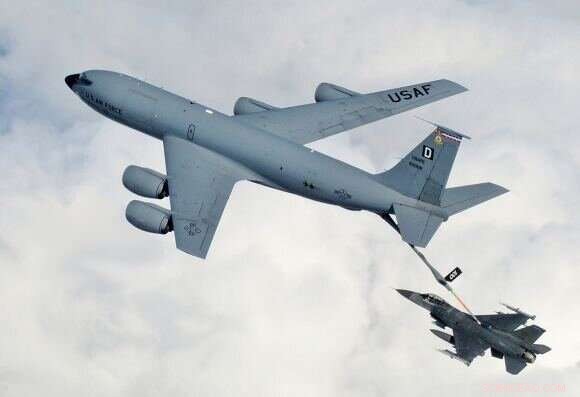
Los satélites se mueven de forma muy predecible. Se mueven rápido pero es relativamente fácil predecir su posición futura e interceptarlos, en muchos casos. Algunos satélites pueden cambiar su altura orbital, pero no tienen maniobrabilidad real y casi no hay forma de evitar un ataque.
"Para describir cómo la física limitaría los compromisos espacio-espacio, Este artículo describe cinco conceptos clave:los satélites se mueven rápidamente, los satélites se mueven de manera predecible, el espacio es grande, tiempo lo es todo, y los satélites maniobran lentamente ".
El vuelo a través de la atmósfera de la Tierra no es exactamente simple, pero es bastante intuitivo. Pero en el espacio es completamente diferente y no se llama exactamente vuelo. Sin atmósfera y baja gravedad, las cosas son muy diferentes. "El movimiento en el espacio es contradictorio para quienes están acostumbrados a volar dentro de la atmósfera de la Tierra y la posibilidad de repostar, "escriben los autores.
"Los enfrentamientos espacio-espacio serían deliberados y probablemente se desarrollarían lentamente porque el espacio es grande y las naves espaciales pueden escapar de sus predecibles trayectorias solo con un gran esfuerzo. Además, los ataques a los activos espaciales requerirían precisión porque las naves espaciales e incluso las armas terrestres pueden atacar objetivos en el espacio solo después de que se determinen cálculos complejos en un dominio altamente diseñado ". No habría un cuadro de pilotos de combate en espera, esperando para revolver y lanzar rápidamente. En lugar de, una batalla espacial que involucra satélites es más un ejercicio matemático.
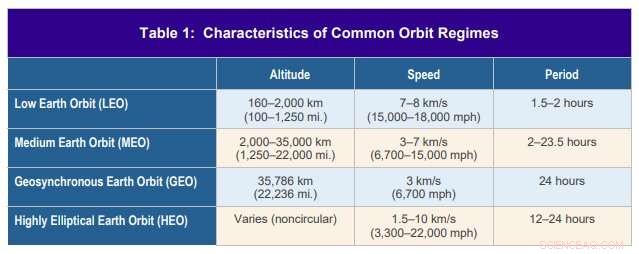
Las órbitas de los satélites son predecibles y no dependen de la masa del satélite. Crédito:Reesman y Wilson 2020.
"Esto es cierto porque la física impone limitaciones a lo que sucede en el espacio. Sólo si se dominan estas limitaciones se pueden hacer otras preguntas, como cómo luchar y, Más importante, when and why to fight a war in space, be explored, " escriben.
A satellite's orbit is predictable because of the relationship between speed, altitude and the orbit's shape. At lower altitudes, satellites can experience atmospheric drag. También, the Earth isn't a perfect sphere. But those factors can be accounted for in an attack. "To deviate from their prescribed orbit, satellites must use an engine to maneuver. This contrasts with airplanes, which mostly use air to change direction; the vacuum of space offers no such option, " escriben.
The sheer volume of space is also a factor in a space battle. "The volume of space between LEO and GEO is about 200 trillion cubic kilometers (50 trillion cubic miles). That is 190 times bigger than the volume of Earth."
So tracking satellites accurately in that volume of space will be a continuous challenge, since some will be designed to be undetected. But that's not impossible; satellites are regularly tracked. And since they're not very maneuverable, once a satellite's orbit is detected, monitors can keep track of its trajectory.
The sheer volume of space also means that most space battles would be very short-lived. There won't be any dogfights. "Space is big, which means that a space-to-space engagement is not going to be both intense and long. It can only be one or the other:either a short, intense use of a lot of Delta V for big effect or long, deliberate use of Delta V for smaller or persistent effects."
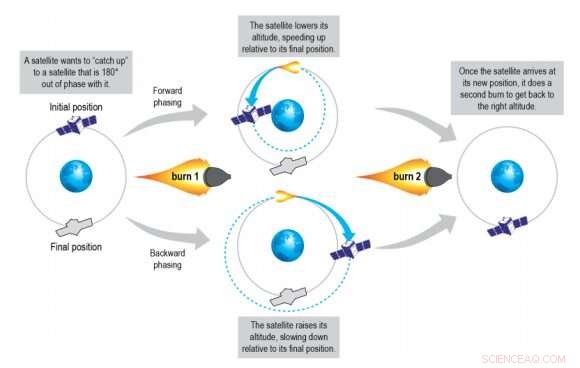
Satellites change their position in their orbit with phasing maneuvers. Any time a satellite raises its orbit, it slows down and appears to be moving backward in relation to its prior orbit and altitude. This is how a satellite can “catch up” to another satellite. Credit:Reesman and Wilson 2020
Delta V is a change in velocity, and that requires fuel or propellant. But most satellites don't have the capability to change their velocity, and the few that might are severely fuel-limited.
"Operators of an attack satellite may spend weeks moving a satellite into an attack position during which conditions may have changed that alter the need for or the objective of the attack." And if the defending satellite is able to only slightly change its own path in response to an attack, then the attacking satellite may not have the capability or the fuel to change its own path to intercept it.
The authors also point out that timing is everything. Even if an attacking satellite can orient itself into the same orbital path as its target, there's still no guarantee of proximity.
"The nature of conflict often requires two competing weapons systems to get close to one another, " the report says. The authors use the example of an aircraft carrier needing to get close to its target, and another of jet fighters that also need to be close to each other. The same thing is true of satellites in space.
"Getting two satellites to the same altitude and the same plane is straightforward (though time and ?V consuming), but that does not mean they are yet in the same spot. The phasing—current location along the orbital trajectory—of the two satellites must also be the same. Since speed and altitude are connected, getting two satellites in the same spot is not intuitive." Instead, it takes perfect timing and meticulous preparation.
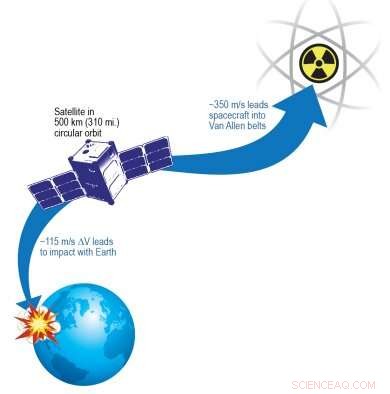
If a satellite performs a forward phasing maneuver with a first burn of 115 m/s or more of ?V, it will reenter Earth’s atmosphere and burn up. Similar, if the satellite performs a backward phasing maneuver with a first burn of 350 m/s or more of ?V, it will experience high radiation in the Van Allen belts. These two facts create natural bounds for how quickly a satellite can maneuver in LEO (500 km or 310 mi.). Credit:Reesman and Wilson 2020
The authors also discuss another method of approaching a target called "plane matching, " A satellite maneuvers itself so that its orbital plane is aligned with a target. That has the advantage of allowing the attacker to dictate the time of the engagement. "By not initiating threatening maneuvers immediately, an attacker may try to seem harmless while waiting for an optimal time to attack, " the authors explain.
But none of these maneuvers happen quickly. "The physics of space dictate that kinetic space-to-space engagements be deliberate with satellites maneuvering for days, if not weeks or months, beforehand to get into position to have meaningful operational effects, " they write. But it can still be done.
And once the interception has been set up, "…many opportunities can arise to maneuver close enough to engage a target quickly."
There are natural limits to how maneuvering satellites in LEO can do. Por un lado, some phasing maneuvers can send the satellite into the Earth's atmosphere where it will be burned up. En el otro, it could be sent too far away from LEO, into the Van Allen Belts. So there are constraints on a satellite's maneuverability.
Satellites in geostationary orbits maintain the same relative position over Earth, so some of the mechanics of attacking and defending are different. But overall, the same constraints are still in place. It takes time and energy to maneuver in space, regardless of the type of orbit.
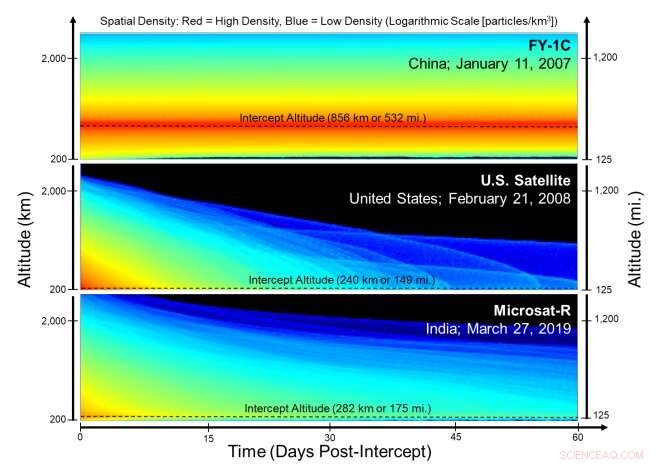
The density of debris is compared at different altitudes as a function of time after the ASAT intercepted (made contact with and destroyed) the target satellite. The Chinese test happened at a much higher altitude (856 km or 532 mi.) than the other two, creating long-lasting debris. Credit:Reesman and Wilson, 2020
But orbital and maneuverability considerations are only a part of what the report addresses.
The authors go on to discuss the types of attacks that can take place. Collisions, projectiles, and electronic jamming or disruption are covered in the paper. Each type has its own considerations and preparations.
But the authors also discuss the aftermath of some successful attacks:complications arising from debris. Additional debris could end up damaging other unintentional targets, like the attacker's own satellites or those of a neutral nation. There have been three successful anti-satellite attacks:one by China, one by the U.S., e India. The authors prepared a graphic to show the debris from each one.
The debris cloud from an attack is denser immediately after the attack and spreads out quickly. Even though debris density is lowered quickly, the debris spreads out over a larger area and is still hazardous.
The paper is a clear presentation of all of the difficulties with space battles and how much different they would be compared to air-to-air battles. But some other considerations that are still important are outside its scope.
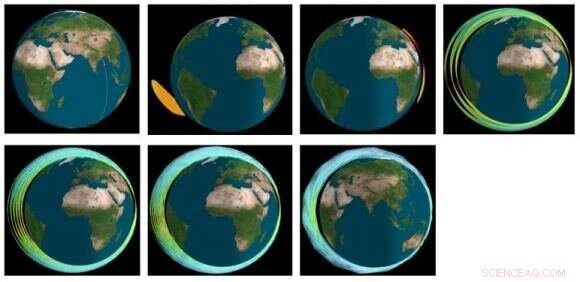
This image shows the debris cloud from the Indian ASAT in 2019. The panels show the cloud at 5 min., 45 min., 90 min., 1 day, 2 días, 3 días, and 6 days after the attack. Credit:Reesman and Wilson 2020
What happens when one nation deduces that their satellites are about to be attacked? They won't sit on their thumbs. They'll likely denounce, threaten, and even retaliate here on Earth. A space attack could end up being a flashpoint for another terrestrial war.
There could end up being an arms race in space, where nations compete to outspend each other on space weaponry and other technology. That's a huge strain on resources for a world that should be focused on meeting the challenge of climate change.
Y, where does it all end? War in orbit? War on the moon? War on Mars? When will humanity figure it out and just stop?
Un día, quizás, there'll be a final war before we give it all up. But that won't likely be in the next 50 years.
And if there is a war in the next 50 years or so, it may involve satellites, and it may look a lot like how the authors of this report have laid it out:slow, calculated, and deliberate.